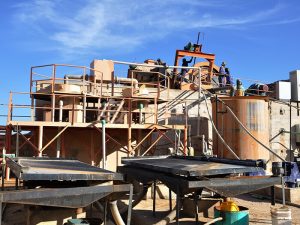Mineral Processing Device Shaking Gravity Separation Table
2025-06-28 10:16:49

Made of fiberglass, wood, or composite materials with riffles (grooves) to trap heavy particles.
Slightly inclined (typically 1°–5°) to allow lighter particles to wash away.
Feed & Water Distribution
A slurry (mix of ore + water) is fed onto the table.
Water flow helps stratify particles by density.
Longitudinal Vibration (Shaking Motion)
The deck moves back and forth (asymmetric motion) via a head mechanism (e.g., eccentric cam or electromagnetic drive).
This motion pushes heavy particles toward the concentrate discharge end.
Transverse Tilt & Water Flow
The table is tilted sideways (cross slope), allowing lighter particles to be washed off by water.
Heavy minerals (e.g., gold, tungsten) settle in riffles and move toward the higher side.
Separation Zones
Concentrates – High-density particles collected at the upper end.
Middlings – Mid-density particles in the middle.
Tailings – Light waste materials washed off the table.
Differential Settling: Heavy particles settle faster and resist water flow.
Stratification: Vibration stratifies particles by density.
Riffle Trapping: Riffles catch dense minerals while water carries away lighter ones.
Applications
Gold, tin, tungsten, chrome, iron ore concentration.
Coal cleaning & rare earth mineral recovery.
Lab-scale & industrial-scale mineral processing.